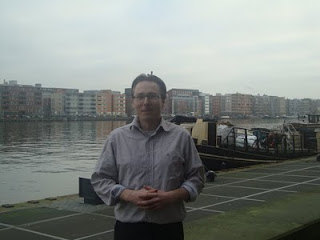Sunday, August 11, 2013 -  conservation,cultural property,Enez,Turkey
conservation,cultural property,Enez,Turkey
 No comments
No comments
 conservation,cultural property,Enez,Turkey
conservation,cultural property,Enez,Turkey
 No comments
No comments
Enez: Bulgaria - Turkey IPA Cross-Border Program Highlights Multicultural History of Castle Ruins in Northern Aegean Beach Town
 |
| Enez Castle (Acropolis) - Restored by Turkish Ministery of Culture and the Department of Cultural Assets & Museums |
by Catherine Sezgin, ARCA Blog Editor
ENEZ, Turkey – The tiny town of Enez, with its long sandy
beaches and view of the Greek mainland, has a big summer population and an even
grander history hidden in the ancient ruins of its castle. Recently the
Bulgaria – Turkey IPA Cross-Border Program has replaced the old Turkish signs
with bilingual placards telling of the site’s history as the ancient city of “Ainos”
where the river Meriç (“Hebros”) meets the sea:
Herodotus
mentioned that Ainos was first founded during the 7th century B.C.
by Aeois, as a colony of those Aeols, who settled North of Izmir. On the other
hand, we learn from other ancient written sources, that before this period, in
Ainos there were cities or villages named Poltyobria and Apsinthos, founded by
Thracian tribes.
Numerous people and rulers came
and left Ainos before turning it over to Ottoman rule: the Persian Kings Darius and
Xerces from 513-480 BC; Macedonians in the 4th century; Romans
beginning in the 2nd century; and during the final era of the
Byzantine Empire, the Genoans under the sovereignty of the Gattelusi and Doria
families. After the death in 1455 of the Ainos ruler Palmede (of the Dorian
family), an ‘internal struggled started for the rule of the city’ and ‘when the
administration stopped paying the yearly tribute to the Ottoman Empire’, the
citizens ‘handed the keys to the city’ to Mehmet the Conquerer when his Navy
besieged the city (Bulgaria-Turkey IPA Cross-Border Program).
 |
| This gentleman talks about Enez ruins. |
An older gentleman walking the un-excavated area within the castle walls said that he came to Enez in 1948 from Bulgaria and served as a guard here. The site is open and free to the public. The population of the town increased after the 1950 when the Balkan countries and Turkey exchanged minorities. Recently a portion of the church has been restored with columns that had lain on the ground. When the wine cellars were excavated, multiple layers of the city were discovered and excavation work ceased. Over the years, he said, the bigger pieces of cultural objects were moved to the Archaeology Museum in Edirne.
According to the signage, in the trenches within the castle (acropolis), on top of the main rock, underneath a soil layer of 7.50 m, terracotta remains that date back to the 4th and 3rd millennia BC reveal that the settlement here dates back to the chalcolithic period. On top of this layer, which reveals the earliest settlement in Enez, finds that date back to the later Greek settlement period have been unearthed.... Ainos produced grain, salt and dried fish as well as oil and wine.
 |
| Restored decorations inside collapsed church/mosque |
The remains of the building known as the Fatih Mosque used to be the local Haghia Sophia Church, one of the most important domed basilicas of the Byzantine era (dating back to the 6th, 9th or 10th centuries). It was destroyed by an earthquake in 1965 and abandoned a year later. Restoration work has been ongoing since the Ottoman years.
 |
| Ruins of an 11th century chapel |
 |
| Christian symbol in basilica ruins |

















